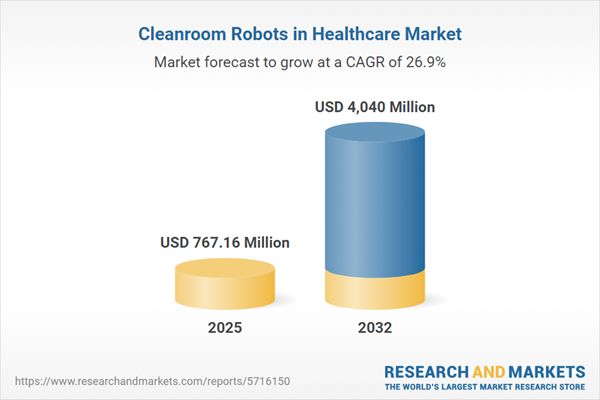Speak directly to the analyst to clarify any post sales queries you may have.
Cleanroom robots are reshaping healthcare facilities by optimizing contamination control, enhancing operational efficiency, and providing consistent automation for hospitals, laboratories, and pharmaceutical environments. Senior decision-makers are adopting these solutions to support robust process standardization and ensure long-term compliance.
Market Snapshot: Cleanroom Robots in Healthcare Market
The global Cleanroom Robots in Healthcare Market is entering a phase of rapid expansion, with projected revenues reaching USD 601.81 million in 2024 and an anticipated compound annual growth rate (CAGR) of 26.89%. Market forecasts indicate continued momentum, fueled by greater integration of robotics in clinical and laboratory settings. The prioritization of enhanced safety protocols, the need for streamlined procedures, and mounting regulatory demands are driving organizations to implement adaptive automation. Increasing adoption is further supported by efforts to accelerate digital transformation and meet rigorous, evolving compliance requirements across diverse healthcare operations.
Scope & Segmentation
- Robot Types: Disinfecting robots deliver environmental hygiene, inspection robots support live facility monitoring, material handling robots optimize logistics, and surface-cleaning robots focus on reducing contamination risks.
- Applications: Robotics are utilized for specimen transport, asset management, and ongoing disinfection, benefitting operational areas such as hospital corridors, surgical suites, pharmaceutical production, and laboratory research environments.
- Functional Focus: Systems feature HEPA filtration, UV-based air purification, chemical and autoclave-based sterilization, tailored cleaning protocols, and automated waste management, all designed to uphold stringent contamination prevention goals.
- Mobility Patterns: Platforms with legged, wheeled, tracked, or wall-climbing capabilities efficiently navigate complex healthcare layouts and adapt to unique spatial constraints.
- Geographic Coverage: Adoption spans the Americas, EMEA, and Asia-Pacific, with solutions tailored to compliance expectations and facility requirements in each region’s healthcare systems.
- Key Technology Providers: Global leaders such as FANUC Corporation, Yaskawa Electric Corporation, ABB Ltd, KUKA Aktiengesellschaft, Kawasaki Heavy Industries, Nachi-Fujikoshi Corp., Seiko Epson Corporation, DENSO Corporation, Omron Corporation, and Universal Robots A/S provide robotics technologies specific to healthcare applications.
Key Takeaways for Senior Decision-Makers
- Standardized automation practices drive higher compliance and reduce manual intervention, supporting both hygiene and logistical workflows.
- Artificial intelligence in robotics enables platforms to adapt quickly as protocols change, ensuring continuity in infection prevention and operational routines.
- Modular, scalable robot architecture allows organizations to adjust or expand deployments in response to shifting regulatory and care delivery models.
- Strategic alliances with equipment manufacturers and systems integrators help achieve rapid certification and continuous conformance to current industry standards.
- Centralized digital management enhances fleet oversight, supports planned maintenance, and helps avoid unexpected system downtime.
- Seamless integration with digital health systems encourages smooth implementation, aligning automation objectives with ongoing digital transformation strategies.
Tariff Impact on Cleanroom Robotics Supply Chains
Changes in US tariffs on precision robotics have directly influenced procurement and supply chain practices in healthcare settings. Providers are increasingly turning to regional and nearshore manufacturing partners, broadening supplier networks, and refining inventory approaches. These measures support continued system availability and help counter the effects of shifting trade policies, containing cost inflation and minimizing disruption risks to ongoing automation initiatives.
Methodology & Data Sources
The market assessment is based on direct discussions with facility managers, laboratory supervisors, and operational leaders, validated through regulatory review and patent tracking. Input from subject matter experts and analysis of technical literature supplement the findings, ensuring practical relevance and strategic applicability.
Why This Report Matters
- Provides executives with clear, actionable guidance for optimizing resources, segmenting needs, and managing operational risk within the specific context of their regional and organizational environments.
- Supports procurement and technology teams in assessing and configuring robotics solutions for ongoing compliance and seamless technology integration.
- Prepares organizations for agile automation strategies and ongoing regulatory adaptation, building resilience in dynamic healthcare operations.
Conclusion
Healthcare leaders can use this report to inform automation strategies, fortify organizational stability, and drive sustained improvement as operational landscapes evolve.
Additional Product Information:
- Purchase of this report includes 1 year online access with quarterly updates.
- This report can be updated on request. Please contact our Customer Experience team using the Ask a Question widget on our website.
Table of Contents
3. Executive Summary
4. Market Overview
7. Cumulative Impact of Artificial Intelligence 2025
Companies Mentioned
The companies profiled in this Cleanroom Robots in Healthcare market report include:- FANUC Corporation
- Yaskawa Electric Corporation
- ABB Ltd
- KUKA Aktiengesellschaft
- Kawasaki Heavy Industries, Ltd.
- Nachi-Fujikoshi Corp.
- Seiko Epson Corporation
- DENSO Corporation
- Omron Corporation
- Universal Robots A/S
Table Information
| Report Attribute | Details |
|---|---|
| No. of Pages | 186 |
| Published | November 2025 |
| Forecast Period | 2025 - 2032 |
| Estimated Market Value ( USD | $ 767.16 Million |
| Forecasted Market Value ( USD | $ 4040 Million |
| Compound Annual Growth Rate | 26.8% |
| Regions Covered | Global |
| No. of Companies Mentioned | 11 |









